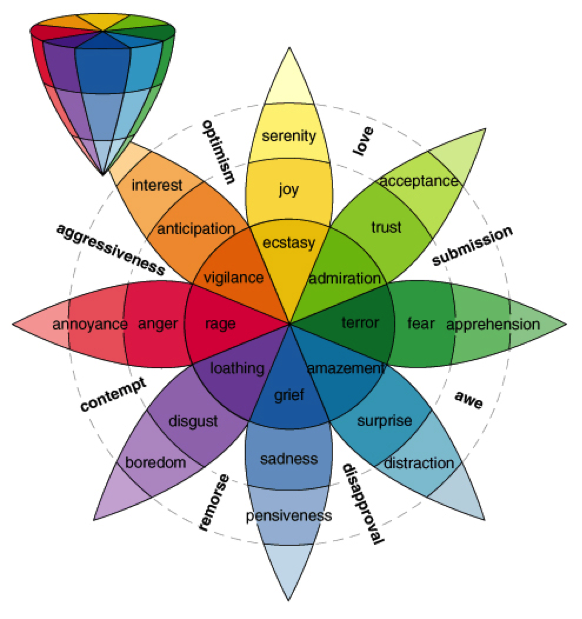Project Objectives
- Review the Components of Art: Subject Matter, Content, Form & Context. CLO 4, 5, 6, 7, 8.
- Explore photography as a communication medium. CLO 1, 8.
- Promote visual understanding of the differences between subject matter, content, form and context. CLO 4,5, 6, 7, 8.
- Explore light, depth the field and vantage point to define the emphasis of the photographic image. CLO 2, 3, 6.
Project Description
Choose three (3) different emotions from the chart above.
Using everything we have learned this semester about the Elements of Design and the Compositional Principles shoot three (3) photographs illustrating the three (3) emotions you have selected (1 for each emotion).
Each shot must include at least one of the Elements of Design and one of the Compositional Principals.
Project Considerations
Elements of Design: Line, Shape, Space, Texture, Value, Color.
Compositional Principles:
- Balance: Symmetry, Asymmetry, Radial Space Division, Frame within a Frame
- Unity: Rule of Thirds, Continuation, Repetition, Alignment, Proximity
- Emphasis & Focal Point: Contrast, Isolation, Convergence, the Unusual, Placement
Obviously how one visually interprets an emotion is subjective, but the viewer (the professor and the class) should be able to understand to some degree which emotion you are trying to communicate. For instance if you have a sunny pleasant image and tell us it is grief, there is a problem.
Step-by-step Directions
Part 1: Look at the work of Gregory Crewdson and Zeke Berman and think about the way in which they use lighting to evoke particular feelings within the viewer:
GREGORY CREWDSON: Video Images This site is a little convoluted—you have to click into each exhibition and then on the left you can click “View Images”. Make sure you check out the exhibitions, Twilight, Gregory Crewdson & Gregory Crewdson: Beneath the Roses.
ZEKE BERMAN Check Color: 2003 to 2008
Discuss the artists and artworks in class.
Part 2: Plan and create a simple still life and photograph it three times without moving your camera. Use only changes in lighting to evoke three distinct moods, for example tranquility, danger, mystery, joy, etc. Remember to fill the whole frame– think about the rule of thirds, focal point, and a balance of negative/positive spaces.
Be creative with your various light sources: a flashlight, a desk lamp, living room lamp, candles, Christmas lights, sunlight, etc.
Part 3: Even though the end result of your work will be three images, you will probably shoot around 60 – 100 images (20 – 30 of each scene if not more). Don’t compromise your final piece by not exercising patience and getting enough pictures! Make sure that you are shooting in RAW. Document the way that you set-up your lighting scenarios. These “behind the scenes” images are great learning tools and fun to see!
Part 4: Upload all your images to your Online Digital Portfolio. Create 1 set of contact sheets with every image you shot for this assignment. Do not edit out your mistakes, crop, or adjust any of the images. Present the raw photos and contact sheets in class for critique.
Part 5: Create a second contact sheet with your three strongest images (each one of these images should have a different lighting set-up) and write down the significant metadata (ISO, Shutter Speed, Aperture) next to each image along with a quick drawing of the Histogram.
Part 6: Take some time to evaluate your artistic decisions and thoughts around this project. The project should be uploaded to your Digital Online Portfolio before 10 am on the Final Assessment meeting and presented as part of yourDigital Online Portfolio. You should include three final (3) shots of different emotions plus ALL original images. Beneath each final shot you must include which emotion, which Elements of Design and which Compositional Principles are being used.
Grading Criteria
This project is worth 8 points
- Did you research the artists and discussed them in class?
- Did you plan the setting and composition based on the decided emotions?
- Do your photos show an awareness of the emotional connotations of light?
- Did you present the work for critique?
- Did you improve the work based on the critiques?
- Do your photos demonstrate your understanding + application of balance negative + positive space?
- Do your photos demonstrate your understanding + application of the rule of thirds?
- Did you write down the metadata for the above images?



